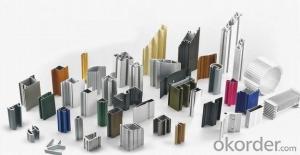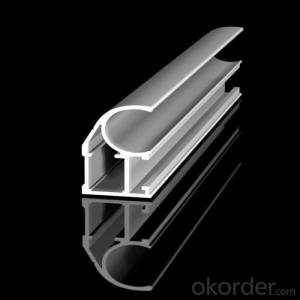Aluminium Profile for Cars Auto-parts Good Quality
- Loading Port:
- Guangzhou
- Payment Terms:
- TT OR LC
- Min Order Qty:
- 5 m.t.
- Supply Capability:
- 1000 m.t./month
OKorder Service Pledge
OKorder Financial Service
You Might Also Like
Item specifice
1.Structure of Aluminium Profile for Cars Auto-parts Good Quality Description:
Anodizing (also spelled anodising, particularly in the UK and Australia) is an electrolytic passivation process used to increase the thickness of the natural oxide layer on the surface of metal parts. Anodized aluminium surfaces, for example, are harder than aluminium but have low to moderate wear resistance that can be improved with increasing thickness or by applying suitable sealing substances.
2.Main Features of the Aluminium Profile for Cars Auto-parts Good Quality:
High corrosion-resistance;
weather-resistance;
heat-resistance;
alkali-resistance and impact-resistance properties.
3.Aluminium Profile for Cars Auto-parts Good Quality Images:
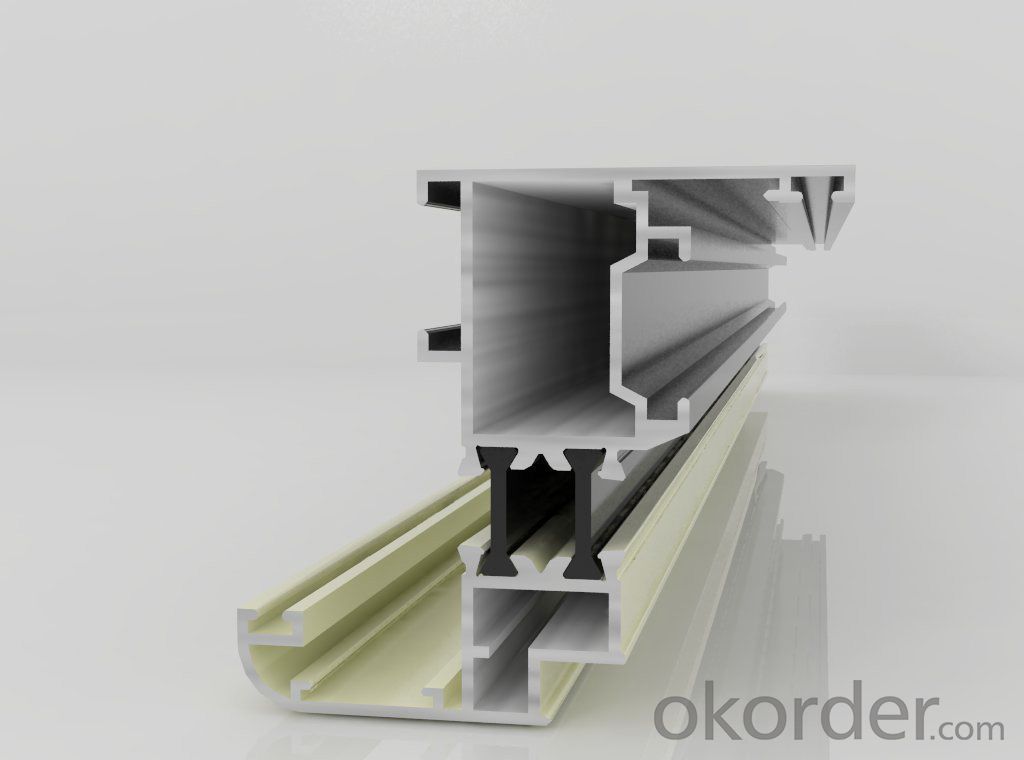
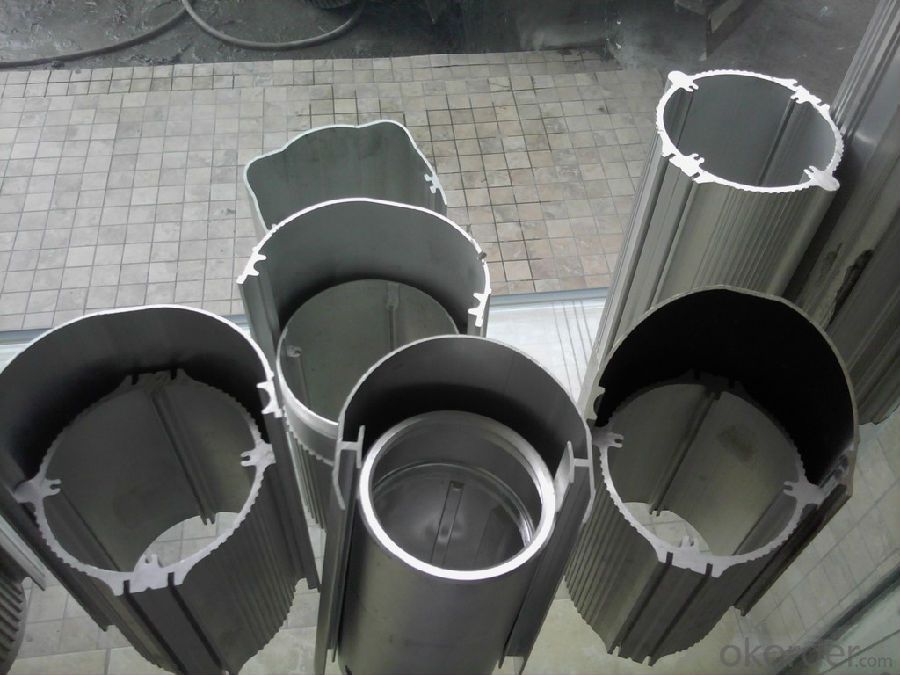
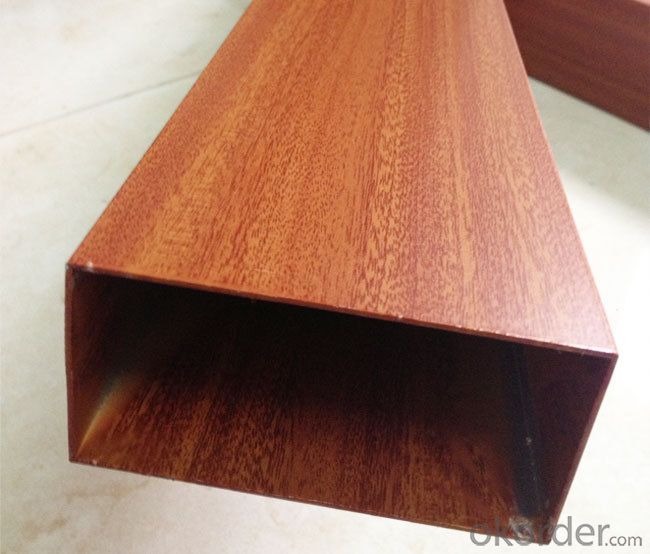
4.Aluminium Profile for Cars Auto-parts Good Quality Specification:
1. Material: 6063,6061,6060,6005,6005A,etc.
2. Temper: T5 or T6
3. Finish: Mill finish, anodizing, powder coating, electrophoresis, wooden transfer or pvdf/carbon-flouride coated, polishing, brushing, sand blasting
4. Various colors: Silver, bronze, black, gold, blue, grey, champagne, bright, etc.
5. Machining: Cutting, punching, drilling, tapping, milling, bending, welding, CNC etc.
5.FAQ:
①How about your company?
A world class manufacturer & supplier of castings forging in carbon steel and alloy steel,is one of the large-scale professional investment casting production bases in China, consisting of both casting foundry forging and machining factory. Annually more than 8000 tons Precision casting and forging parts are exported to markets in Europe, America and Japan. OEM casting and forging service available according to customer’s requirements.
②How to guarantee the quality of the products?
We have established the international advanced quality management system,every link from raw material to final product we have strict quality test;We resolutely put an end to unqualified products flowing into the market. At the same time, we will provide necessary follow-up service assurance.
- Q:Can aluminum profiles be used for framing mirrors?
- Yes, aluminum profiles can be used for framing mirrors. Aluminum is a lightweight and durable material that can provide a sleek and modern look to mirror frames. It is also resistant to corrosion, making it suitable for use in bathrooms or other areas with high humidity. Additionally, aluminum profiles can be easily customized and come in various finishes, allowing for flexibility in design.
- Q:What are the color options available for aluminum profiles?
- The color options available for aluminum profiles are vast and can be customized to suit individual preferences and design needs. Some common color options include natural aluminum (silver), white, black, bronze, and various shades of grey. Additionally, it is possible to select custom colors by applying powder coating or anodizing processes to the aluminum profiles. These processes allow for a wide range of colors to be achieved, including vibrant hues and metallic finishes. Ultimately, the color options for aluminum profiles are extensive, enabling individuals to find the perfect match for their specific project or aesthetic requirements.
- Q:What is the difference between aluminum profile and sheet metal?
- Aluminum extrusions can be produced by extrusion or casting. In contrast, the aluminum sheet is flat, mainly for all types of surface.
- Q:What are the different finishing options available for aluminum profiles?
- There are various finishing options available for aluminum profiles to enhance their appearance and provide additional protection. These options can be broadly categorized into surface treatments and coatings. Surface treatments include anodizing, powder coating, and polishing. Anodizing is a popular technique that involves creating a durable and corrosion-resistant layer on the aluminum surface through an electrochemical process. It provides a wide range of colors and finishes while maintaining the metallic look. Powder coating involves applying a dry powder to the aluminum surface and then curing it using heat, resulting in a smooth and durable finish. Polishing is another option that involves mechanically smoothing the surface of the aluminum, giving it a reflective and glossy appearance. Coatings, on the other hand, involve the application of a protective layer on the aluminum. These coatings can be organic or inorganic. Organic coatings, such as paint or lacquer, provide a decorative finish and protect the surface from scratches and oxidation. Inorganic coatings, such as ceramic or enamel, are more durable and resistant to abrasion, heat, and chemicals. Additionally, aluminum profiles can also undergo mechanical finishing processes like brushing or sandblasting. Brushing gives the aluminum a textured finish by using abrasive brushes to create a pattern on the surface. Sandblasting involves forcibly propelling fine particles at high speed to roughen the surface, giving it a matte appearance. The choice of finishing option depends on the intended application, aesthetic preference, and the desired level of protection. Each option has its advantages and disadvantages, so it is essential to consider factors like durability, maintenance, and cost before selecting the appropriate finishing option for aluminum profiles.
- Q:Can aluminum profiles be used in marine environments?
- Yes, aluminum profiles can be used in marine environments. Aluminum is often chosen for its excellent corrosion resistance and lightweight properties, making it ideal for marine applications. It is commonly used in the construction of boats, shipbuilding, and offshore structures due to its durability and ability to withstand exposure to saltwater and harsh weather conditions.
- Q:How do aluminum profiles compare to other types of materials?
- Aluminum profiles have several advantages over other types of materials. Firstly, aluminum is lightweight, making it easier to handle and transport. It is also highly resistant to corrosion, making it ideal for outdoor or high-moisture environments. Additionally, aluminum profiles offer excellent strength-to-weight ratio, providing structural stability without unnecessary weight. Moreover, aluminum is a highly versatile material that can be easily shaped and customized to meet specific design requirements. Lastly, aluminum is sustainable and recyclable, making it an environmentally friendly choice. Overall, aluminum profiles offer numerous benefits in terms of durability, versatility, and sustainability compared to other materials.
- Q:Top 10 ranking enterprises of aluminum profiles in China
- Don't just look at rankings, which is something false, we all know in the aluminum industry, aluminum extrusion and some more than 50 units, annual production capacity of 90 thousand tons, were stronger than some ten enterprises inside the above you can see, but in the rankings but no, this ranking is water.
- Q:Can aluminum profiles be used for modular shelving systems?
- Indeed, modular shelving systems can effectively utilize aluminum profiles. This lightweight and robust material provides exceptional durability and corrosion resistance. Its adaptability enables its suitability for diverse applications, including shelving systems. By effortlessly customizing and adjusting aluminum profiles, one can effortlessly fashion modular shelving units of varying dimensions and layouts. Furthermore, the ease of assembly and disassembly of aluminum profiles makes them an ideal choice for adjustable or expandable modular systems. Ultimately, aluminum profiles offer a dependable and visually appealing answer for modular shelving systems.
- Q:What are the different extrusion methods used for aluminum profiles?
- There are several different extrusion methods commonly used for aluminum profiles. These methods include: 1. Direct extrusion: This is the most common method used for aluminum extrusion. In this process, a heated billet of aluminum is forced through a die using a ram. The aluminum is pushed through the die, which shapes it into the desired form. Direct extrusion is a highly efficient and cost-effective method. 2. Indirect extrusion: In this method, the billet is held stationary while the die moves towards it. The die pushes the aluminum through the stationary billet, shaping it into the desired form. Indirect extrusion is often used for more complex shapes or when a higher level of precision is required. 3. Impact extrusion: This method involves forcing a billet of aluminum into a die cavity using a punch. The punch strikes the billet with high force, causing it to flow into the die and take its shape. Impact extrusion is commonly used for producing hollow parts or tubes. 4. Hydrostatic extrusion: This method involves using a fluid, usually oil or water, to pressurize the billet and force it through a die. The high pressure of the fluid allows for greater control and precision in shaping the aluminum. Hydrostatic extrusion is often used for producing high-quality, high-strength aluminum profiles. 5. Cold extrusion: In this method, the aluminum billet is extruded at room temperature. The lower temperature helps to achieve greater strength and better surface finish. Cold extrusion is commonly used for producing small, intricate aluminum profiles. Each of these extrusion methods has its own advantages and is suitable for different applications. The choice of method depends on factors such as the complexity of the profile, desired strength, surface finish requirements, and cost considerations.
- Q:What are the advantages of using aluminum profiles in the mining industry?
- There are several advantages of using aluminum profiles in the mining industry. Firstly, aluminum profiles are lightweight yet strong, making them ideal for use in mining equipment. This allows for easier transportation and installation of mining machinery, resulting in increased efficiency and reduced costs. Secondly, aluminum profiles are highly resistant to corrosion. In the mining industry, where equipment is exposed to harsh environments and corrosive materials, this is a significant advantage. The durability of aluminum profiles ensures that mining equipment remains in good condition for longer periods, reducing maintenance and replacement costs. Additionally, aluminum profiles are non-magnetic, which is crucial in mining operations involving magnetic materials such as iron ore. This property prevents interference with sensitive mining equipment, ensuring accurate measurements and efficient operations. Moreover, aluminum profiles are highly versatile and can be easily customized to suit the specific needs of mining operations. They can be machined, welded, and formed into various shapes and sizes, allowing for the creation of tailor-made structures and equipment. This flexibility facilitates innovation and optimization in the mining industry. Furthermore, aluminum profiles have excellent thermal conductivity. In mining applications where temperature control is essential, such as in smelting or refining processes, this property is advantageous. Aluminum profiles can efficiently dissipate heat, preventing equipment from overheating and ensuring optimal performance. Lastly, aluminum profiles are highly sustainable. Aluminum is a widely recycled material, and using aluminum profiles in the mining industry promotes a circular economy and reduces environmental impact. The recyclability of aluminum profiles also offers cost savings in the long run. In conclusion, the advantages of using aluminum profiles in the mining industry include their lightweight yet strong nature, resistance to corrosion, non-magnetic properties, versatility, thermal conductivity, and sustainability. These benefits contribute to improved efficiency, reduced costs, and enhanced environmental performance in mining operations.
1. Manufacturer Overview |
|
|---|---|
| Location | |
| Year Established | |
| Annual Output Value | |
| Main Markets | |
| Company Certifications | |
2. Manufacturer Certificates |
|
|---|---|
| a) Certification Name | |
| Range | |
| Reference | |
| Validity Period | |
3. Manufacturer Capability |
|
|---|---|
| a)Trade Capacity | |
| Nearest Port | |
| Export Percentage | |
| No.of Employees in Trade Department | |
| Language Spoken: | |
| b)Factory Information | |
| Factory Size: | |
| No. of Production Lines | |
| Contract Manufacturing | |
| Product Price Range | |
Send your message to us
Aluminium Profile for Cars Auto-parts Good Quality
- Loading Port:
- Guangzhou
- Payment Terms:
- TT OR LC
- Min Order Qty:
- 5 m.t.
- Supply Capability:
- 1000 m.t./month
OKorder Service Pledge
OKorder Financial Service
Similar products
New products
Hot products
Related keywords

